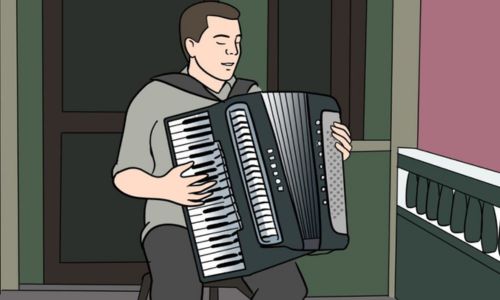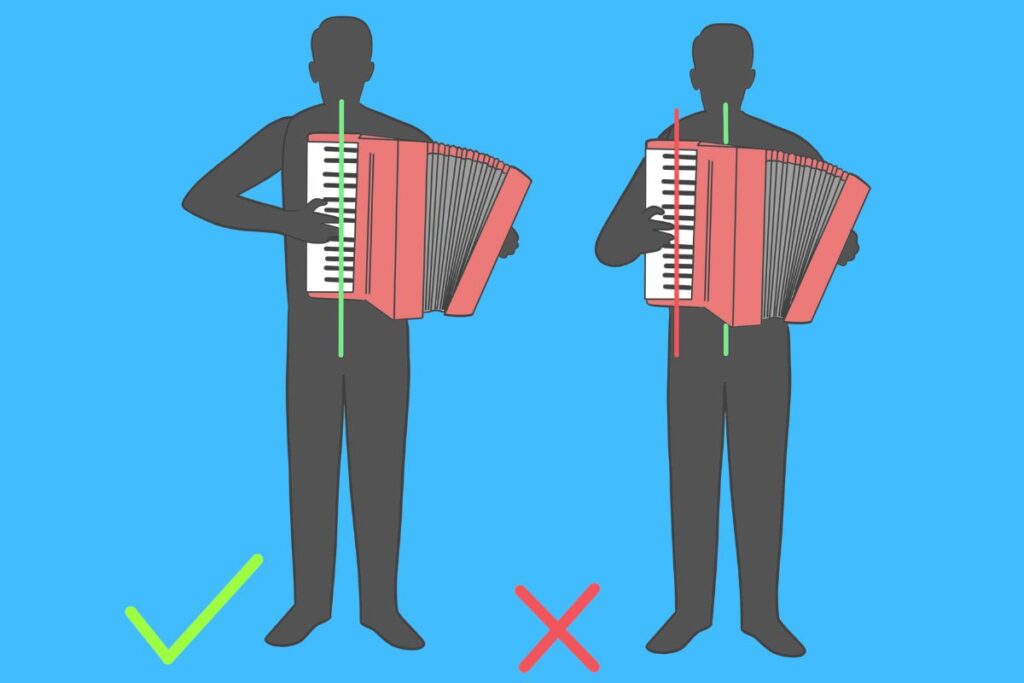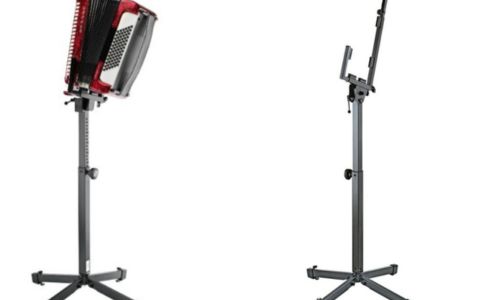When it comes to playing the accordion, posture is key. It’s important for accordionists to maintain good posture in order to prevent injury and ensure their physical health. In this article, we’ll discuss some tips on how to improve your postural safety and health while playing the accordion.
Learning to play the accordion requires an understanding of proper hand positioning and instrument handling. This critical step helps protect against future problems such as muscular fatigue, back strain, and an inability to properly execute complex pieces. With correct posture that allows smooth movement between both hands while sitting or standing, it’s possible for any beginner musician to master this exciting instrument.
Playing the accordion sitting down
The first step in improving your postural safety while playing the accordion is to make sure you are sitting up straight. Slouching can cause strain on your back and neck muscles, leading to pain or even injury.
To ensure stability and secure your playing, anchor the keyboard inside your right leg. Have both legs parallel but not too close together – a good way to test out how far should they be apart is by sandwiching two fists between them. Now you’re ready for some steady squeezin’!

Make sure that you are sitting with a straight back, shoulders rolled back, and feet flat on the floor. This will help keep your spine in proper alignment and reduce any potential strain or discomfort.
When playing the accordion, make sure your elbow is in line with the keyboard. And remember to use a natural position for your left hand – bend those fingers slightly so they can nimbly push bass buttons with just their tips. Don’t forget that when sitting down you must keep most of the instrument’s weight balanced on your left leg.
Playing the accordion standing up
To achieve an optimal playing experience while performing with your accordion, stand tall and keep the instrument comfortably against your chest. Make sure it’s level to the floor for maximum accuracy and stability; this will help prevent any disorienting movement during performance so you can stay focused on playing the instrument. (diagram below shows the proper posture and elbow positioning).
Maintain a good posture when playing the accordion, adjusting your shoulder straps so that it sits in alignment with the floor – this will provide better stability while you perform. Keeping the keyboard portion firmly against your chest gives further support to ensure minimal shifting.
If you’re looking for an easier way to play your accordion while standing up, there are several solutions available. One is a rigid stand that keeps the entire weight of the accordion off your hands and arms.

Or if that’s not ideal due to size or portability concerns, you can get a monopod attachment instead perfect for heavier models like my old 40-pounder! Either way makes it much more comfortable when playing live music sets.

Another important aspect of postural safety for accordionists is ensuring that the instrument itself is properly positioned. The weight of the instrument should be evenly distributed between both arms so that one arm does not have more weight than the other.
Importance of the straps
Accordion straps do more than just keep your instrument in place – they provide essential support by evenly distributing the weight of an accordion, so you can jam out worry-free. If you would like to learn more about the accordion straps, how are they mounted, and which one would be the best option for your accordion, read this article.
Make sure you get the fit of your accordion straps just right. A slightly longer strap on your right side allows for greater freedom in playing up and down, while a more snug left strap helps with controlling how far out or close together to move the bellows.
Accordionists seeking to perform a more vigorous style of playing must utilize a backstrap in combination with shoulder straps. These sturdy attachments keep the instrument securely entrenched, eliminating any sway or flutter while playing – perfect for achieving optimal performance.
And don’t worry if you’re new to accordions; snap-backstraps are designed so that even beginners can attach them on easily.
Positioning is key – ensure that when strapping yourself in, your keyboard will be set at chin height for optimum comfort and control as you play.
Playing the accordion smoothly and accurately requires your body to be in just the right position. Make sure that your shoulder straps are tight, yet not constricting – you don’t want them cutting off circulation but you also don’t want them slipping as you move around notes.
Your left arm should remain between bellow-strap and board while it is important for accuracy with the right hand to keep both elbow and wrist parallel with each other along keyboard’s edge. With some practice, proper form will help make a harmonious melody from this unique instrument.

Proper elbow and finger positioning
To ensure the best keyboarding experience, make sure your wrists are comfortably at rest with no strain. Your elbow should stay aligned to the keys whether you go up or down – just not too high! Let your left hand settle into a natural angle and curl those fingers slightly so that when playing bass buttons only light fingertip pressure is required for optimal results.
To get the best sound out of your accordion bass buttons, it is important to position yourself correctly. Make sure that you are close enough so that when pressing down on a button with your finger, you only have to move ever-so slightly off the tip – this will ensure an optimal outcome
Additionally, make sure that you are not having to reach too far forward or backward when pressing keys; this can cause fatigue and strain as well as poor technique due to lack of leverage. Finally, take occasional breaks from playing so that your arms and hands do not become overworked or tired from holding up the instrument for extended periods of time.
Weight of the Accordion
Accordionists must be prepared for a fitness challenge when performing – modern instruments may have been lightened up, yet they still weigh an impressive 15-20 pounds! In other words, these musical maestros are giving their bodies quite the workout while entertaining us all.
Investing in an ergonomic accordion stand can be a great way to improve your posture while playing the instrument. An ergonomic stand allows you to adjust the height of the accordion according to your body type and size, meaning it will be easier to maintain good posture without having to expend extra energy keeping yourself upright.
Struggling with the weight of your accordion? Giving yourself some height could make a big difference. A drummer’s throne – adjustable like that on a piano stool – can provide just the right elevation for most players, though its best to align it so that it’s at about the same level as your accordion case’s widest dimension. This simple tip may be enough to help you play comfortably and more confidently.
Additionally, an ergonomic stand will help reduce any neck strain caused by looking down at an overly low-slung instrument while trying to play it.
Postural safety is essential for anyone who plays an instrument such as an accordion—it helps prevent long-term injury or pain while also aiding in better technique overall.
By following these simple tips—sitting up straight with feet flat on the floor, distributing weight evenly between both arms when holding up the instrument, taking frequent breaks from playing, and investing in an ergonomic stand—accordionists can greatly improve their postural safety and health while still enjoying their music-making experience.
Physical exercises for accordionists
Playing the accordion is a wonderful way to bring joy, but it can also strain your upper body over time. To ensure that you keep playing as long as possible no matter what age or fitness level, working on strengthening and conditioning exercises for your arms and shoulders will give powerful returns in terms of longevity with our favorite instrument.
Accordionists are always on the move, so it’s important to keep their bodies in peak physical condition. To achieve this goal, many add exercises like walking and running as well as strength machines such as fly machines and Pilates into their routine. Above all else however – rowing is considered one of the most beneficial for promoting total body conditioning that every accordionist should incorporate.
Posture corrector braces for accordionists
Musicians and singers are dedicated to their fitness and often use tools like posture correctors to enhance their performance. Accordionists particularly believe that posture correctors can greatly improve posture. Among the multiple brands available, Shaperky stands out as a popular choice for back and posture braces.
Adjustable posture corrector for both men and women. This innovative upper back brace is designed to support your muscles and promote muscle memory, straightening your spine for pain relief in your neck, shoulders, upper back.
Conclusion and final thoughts
It is essential for accordion players to prioritize maintaining a posture and overall fitness. Playing this instrument can exert strain on the body over time so its crucial to take care of oneself.
A proper stance not helps prevent injuries and discomfort but also enhances performance by enabling movements and better control of the accordion. Regular exercise focused on strengthening the core and improving flexibility is beneficial, for accordionists as it helps manage the weight of the instrument and allows for playing sessions without fatigue.
Ultimately paying attention to physical being empowers musicians to deliver their performances ensuring that the beautiful and soulful sound of the accordion continues to flourish and inspire others.
Dino is a hobbyist accordionist who loves music, photography, architecture, design and a slew of other fun things. He decided to launch this blog due to an increasing popularity of the accordion. He learned how to play the accordion by ear as a child and then progressed on to keyboards and eventually a drum set. He grew up in the Balkans and now lives in California where he occasionally plays the accordion at birthday parties and NYE celebrations. He now shares his love for the accordion through this blog.







Leave a Reply